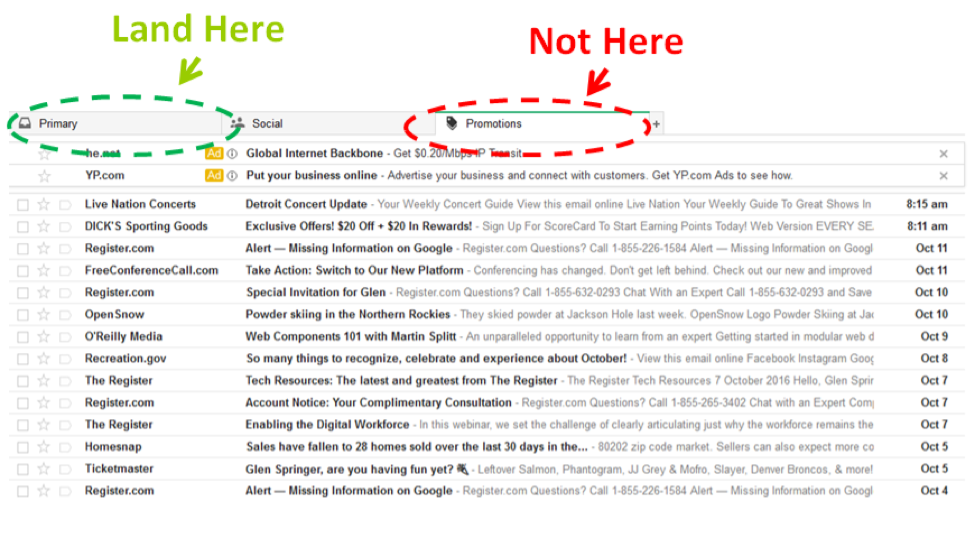
Email Deliverability When Nurturing Leads
In this short article we discuss the importance of email deliverability when nurturing leads to get the most from your demand generation process.
Email deliverability is one of many critical factors in successful lead nurturing. The goals being:
- Stay top of mind so when the buyer is ready to buy, they think of you first
- Educate the buyer on how you approach solving their problems
- Build trust and familiarity with both your brand and your solution
Ensuring that your emails avoid spam filters and make it to the customers’ in-box is the first step to increase the effectiveness of your lead nurturing campaigns. Spam Filters can be challenging. This is especially true for businesses which are marketing to consumers or marketing to smaller businesses that use Gmail accounts.
Be aware, Google has two in-boxes: the “Primary” inbox and the “Promotional” inbox. Successfully hitting a Google user’s primary inbox vs. their promotion box greatly increases the likelihood of engagement.

In this short article we will focus on some of the triggers for spam filters, why emails end caught by filters, and what words B2B marketers should not use to help make your email campaigns more effective.
First, what is a spam filter?
A spam filter is a piece of software that scans incoming emails for unwanted content and blocks them from getting to the user’s inbox. Spam filters are most often used as a security feature to avoid malware and other types of fraud. Filters scrape emails by using algorithms and other techniques to detect common features in known fraudulent emails. This can be specific language, emails with too many links, emails with non-secured links and images with embedded code.
As an enhancement, these filters have now learned to also filter low-value and salesy content, in addition to emails that may distract employees from focusing on their day to day tasks. Filters are now designed not only to keep the company’s network secure, but also to keep employees more productive.
The number one reason marketing emails get filtered
The number one reason marketing emails are filtered is a spam trigger word in your email subject line. A spam trigger word is a type of phrase or term that triggers an automated response, regardless of the actual content. If the filter is triggered, your message is moved to the junk or promotions folder. Spam trigger words are usually words that have multiple meanings, such as “free,” “discount,” or “offer.” Although these words may be used innocently in a professional setting, they are often red flags to spam filters that can cause the message to be flagged as junk or potentially dangerous. As such, it is important to avoid using any spam trigger words in your emails, regardless of context.
Here is a brief list of the types of words that should be avoided in your subject line:
Avoid symbols or exaggerated numbers
- 100%
- 100% satisfied
- #1
- $$$
- 0%
Avoid pushing urgency
- Access now
- Access right away
- Apply NOW
- Buy Now
- Important information regarding
- Limited time
- Limited time deal
- Offer expires
- Once in lifetime
- Save up to
- Sign up free today
Avoid exaggerated claims and a number
- 100% money back
- Best offer
- Best price
- Double your leads
- F r e e
- Free trial
- Lowest price
- Save Big
- You have been selected
- You will not believe your eyes
- Zero chance
- Zero percent
- Zero risk
Avoid words that make your message too salesy
- Affordable
- Bargain
- Cheap
- Confidential
- Easy
The good news is that if you make a mistake and you are using any established Marketing Automation Platform, it will provide a tool to make sure you avoid this issue. For example, Digital Demand Center leverages a Spam Assassin plug-in directly in the workflow for building and programming emails. The software system itself can check the subject lines for viability as they are being programed as part of the spam testing process. However, the tool doesn’t work, if you don’t use it.

Most sophisticated lead nurturing and marketing automation software have tools to check for “spammy messages”
What else causes deliverability issues and how to avoid these issues?
Email providers and email software systems like Google and Outlook use a wide range of criteria to decide how, where and if your email is delivered.
Email Black Lists: An email black list is a listing of IP addresses and/or domain names from which emails are blocked or refused. This type of blacklist helps to protect users from malicious emails that could contain viruses, malware, phishing scams, and other threats. Email service providers often maintain such lists to prevent their customers from being exposed to dangerous content.
Being on an email blacklist, indicates that you’ve been sending emails to people who didn’t subscribe to your email list and is the most critical filter to avoid. The easiest way to get on a black list is going to an online market, buying a list and sending mass emails. The result is often a wave of spam complaints and unsubscribes and then a blacklist.
Avoiding this blacklist is one of many reasons to consider working with a marketing team with email marketing expertise. At Digital Demand Center we work with our clients to warm new email servers, verify subscribers and ensure we send valuable content that recipients will engage with in a meaningful way.
Absence of an unsubscribe link: It’s important to give recipients the option to unsubscribe from your emails.
Having an unsubscribe button in your email is essential for several reasons. First, it ensures compliance with the CAN-SPAM Act of 2003, which requires that all commercial messages have a way for recipients to opt-out of future emails. Second, having an unsubscribe button shows that you respect the wishes of your customers and that their time and preferences are important to you. This will help your company build a trusting relationship with your potential customer base and make them more likely to stick around for future emails.
Poorly-designed emails: Emails that are hard to read because of broken or faulty code create a negative experience for readers.
Marketing automation platforms will ensure you have code that is optimized for deliverability across all systems. And here at DDC, we often advocate that you to go text-only when possible. Text-only emails and simply designed emails, typically have less to be analyzed by email filters and will get delivered successfully to an in-box more frequently.
If you do want to use code, most marketing automation platforms will have a library of customer templates. Working with Digital Demand Center makes customization a breeze.

Impersonal emails/non-personalized emails: Addressing your recipient by “dear” or “my friend” instead of using their name or personalizing the subject line can lower your open rate.
You should always use a customer’s first name in the email subject line to help increase your open rate and encourage engagement. It shows that you are familiar with them and adds a personal touch. It’s also more likely to be delivered direct to their inbox.
Mass-sending messages to invalid email addresses: This result is a high bounce rate which adversely affects your IP reputation. If you operate in Europe, buying email lists could be in violation of GDPR guidelines, which require explicit permission from contacts before sending them marketing emails. It’s important to verify the email addresses on any list prior to using it within your email marketing system.
Use of capital letters and extreme punctuation: Spam detecting software often flags emails formatted in all-caps as spam. Overuse of exclamation marks or question marks could also negatively affect your email.
Strange font formats: Using all caps or quirky/strange fonts are difficult to read and are usually picked up by spam detecting software. Stick to sentence case and the standard fonts like Helvetica, Times Roman etc.
Using even any attachments: The number one way for malware to get into a company’s system is through attachments. Use links only because most companies will set their filters to avoid attachments altogether. It’s also important that you make sure your websites SSL certificate is up to date prior to directing recipients to content on your website.
Limit the use of links: Clear and direct communication starts by making your intention clear. As a best practice, keep your emails focused on one topic to make it easy to engage with. Default to using one or two links for the content offer. Then you may have one additional link for connecting on LinkedIn or your calendar. Avoid using any more than three links. There is one exception to this – newsletters. If you are sending a newsletter, make sure to note that in the subject line.
Conclusion
Effective lead nurturing requires effective email marketing. And effective email marketing requires effective email delivery. Digital Demand Center can help.
Please watch our video below or our Digital Transformation Webcast series to learn more.


